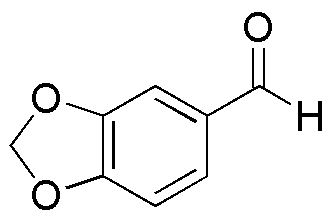Piperonal crystals (Synthetic) is widely utilized in research focused on:
- Fragrance Industry: Commonly used as a key ingredient in perfumes and scented products due to its pleasant, sweet, and floral aroma. This makes it a favorite among fragrance manufacturers looking to create appealing scents.
- Flavoring Agent: Employed in the food industry as a flavor enhancer in products like baked goods and confections, providing a unique taste profile that appeals to consumers.
- Pharmaceuticals: Acts as a precursor in the synthesis of various pharmaceutical compounds, contributing to the development of medications that require specific aromatic structures.
- Cosmetics: Incorporated into cosmetic formulations for its aromatic properties, enhancing the sensory experience of products such as lotions and creams.
- Research Applications: Used in laboratories for organic synthesis and as a reference compound in analytical chemistry, aiding researchers in developing new compounds and understanding chemical behaviors.
General Information
Properties
Safety and Regulations
Applications
Piperonal crystals (Synthetic) is widely utilized in research focused on:
- Fragrance Industry: Commonly used as a key ingredient in perfumes and scented products due to its pleasant, sweet, and floral aroma. This makes it a favorite among fragrance manufacturers looking to create appealing scents.
- Flavoring Agent: Employed in the food industry as a flavor enhancer in products like baked goods and confections, providing a unique taste profile that appeals to consumers.
- Pharmaceuticals: Acts as a precursor in the synthesis of various pharmaceutical compounds, contributing to the development of medications that require specific aromatic structures.
- Cosmetics: Incorporated into cosmetic formulations for its aromatic properties, enhancing the sensory experience of products such as lotions and creams.
- Research Applications: Used in laboratories for organic synthesis and as a reference compound in analytical chemistry, aiding researchers in developing new compounds and understanding chemical behaviors.
Documents
Safety Data Sheets (SDS)
The SDS provides comprehensive safety information on handling, storage, and disposal of the product.
Product Specification (PS)
The PS provides a comprehensive breakdown of the product’s properties, including chemical composition, physical state, purity, and storage requirements. It also details acceptable quality ranges and the product's intended applications.
Certificates of Analysis (COA)
Search for Certificates of Analysis (COA) by entering the products Lot Number. Lot and Batch Numbers can be found on a product’s label following the words ‘Lot’ or ‘Batch’.
*Catalog Number
*Lot Number
Certificates Of Origin (COO)
This COO confirms the country where the product was manufactured, and also details the materials and components used in it and whether it is derived from natural, synthetic, or other specific sources. This certificate may be required for customs, trade, and regulatory compliance.
*Catalog Number
*Lot Number
Safety Data Sheets (SDS)
The SDS provides comprehensive safety information on handling, storage, and disposal of the product.
DownloadProduct Specification (PS)
The PS provides a comprehensive breakdown of the product’s properties, including chemical composition, physical state, purity, and storage requirements. It also details acceptable quality ranges and the product's intended applications.
DownloadCertificates of Analysis (COA)
Search for Certificates of Analysis (COA) by entering the products Lot Number. Lot and Batch Numbers can be found on a product’s label following the words ‘Lot’ or ‘Batch’.
*Catalog Number
*Lot Number
Certificates Of Origin (COO)
This COO confirms the country where the product was manufactured, and also details the materials and components used in it and whether it is derived from natural, synthetic, or other specific sources. This certificate may be required for customs, trade, and regulatory compliance.



